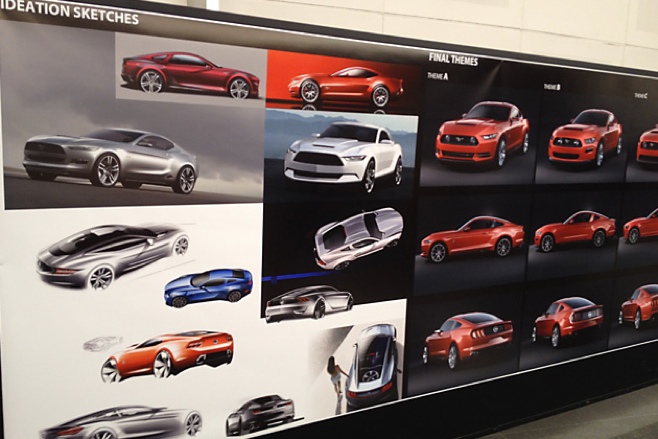A couple months ago, the globe eagerly awaited the unveiling of the all new 2015 Ford Mustang. Its throwback design and radically re-engineered powerplant had pony car fans around the globe drooling en-masse. But what they didn’t tell us was what proceeded behind the scenes for more than four years, to find the new Mustang from pipe dream to road reality.
At the 2014 North American International Auto Show (NAIAS), we had the rare chance to peek behind the Blue Oval and see exactly how the Ford design team reimagined this iconic pony car. Here’s how they did it:
More than four years ago, the team started with countless concept sketches of the two exterior and interior. Everyone wanted to take part in the redesign.
While a lot of the early designs are pretty far available, the interior team had some “musts” to feature, like the Mustang’s big signature dual round gauges, a muscular brow line for the dash, and functional toggle switches. This helped guide the final designs, which took over 2 yrs to decide on.
Interior designs are then rendered in 3D on the pc, and in life size clay models. The 3D renderings have to be ultra precise-they are the actual files that can be sent to manufacturers to produce the final parts.
Clay models are also made as precisely as you possibly can. Senior Interior Designer Sewon Chun told us he prefers to do business with the clay models, while he can sit inside them and get an authentic feel for the design’s influence on drivers.
For the exterior design team, a retro feel by using a modern take was a must. Along with a wide, powerful stance.
Exterior sketches were narrowed down to 20-30 top choices, then are narrowed down again to three “themes” which are more fully developed. All pay homage to a 1968 concept by legendary auto designer, Caroll Shelby.
These are then sculpted out from hundreds of pounds of clay into 3 or 4 life size models so designers can feel and see the automobile. The models are painted. Real wheels are wear. The Ford team of executives and designers spend hours looking and discussing, attempting to decide which a person to take to market.
Theme A was ultimately picked. It possesses a low roofline, and is 50 millimeters wider at the rear with a dramatically lowered deck lid from the outgoing 2014 model. It features strong side lines with wide shoulders along with a narrow waist. In the nod to Shelby, the power dome in front is emphasized. One final clay model sculpted.
The clay model is scanned and digitized. Engineers compare this with actual dimensions, then the model is re-sculpted, millimeter by millimeter, perfectly, then re-scanned and re-digitized.
While all this sculpting is happening, the color team gets rolling with the paint and interior materials that will be available for the newest Mustang.
There are decisions about what paint colors will likely be available at the various trim lines, from base to premium. Along with special paint schemes, like the Triple Competition Yellow and Ruby Red, both of which require 3 coats of paint instead of the usual one coat. (We saw a lovely dark green that reminded us heavily of Bullitt’s Mustang. We’re anxious to see that one on the road.)
The Mustang interiors are all depending on black with little pops of color. Four different interior aluminums are chosen. It took three years to decide on the final exterior and interior colors.
Meanwhile, a new life-sized fiberglass model is milled from the data scanned from your clay model. This model is painted gray and so the team can evaluate exactly how the design looks under different lighting conditions. There is a cutaway on one side of the roof to expose the interior.
Once the final tweaks have already been made to this model, an incredibly exact model is made of the very last specs for the inside and outside. This-off takes modelers, other, painters and sculptors craftsmen roughly 4-5 weeks to perform.
The doors work. It is possible to sit inside it in the actual seats that will be used. It is possible to flip the toggle switches. Handmade, detailed lights are installed front and rear. The chrome badges are made by hand and fixed to the model. Since this is essentially the finished product for the team to review, the fit and finish needs to be perfect.
This model is eye-poppingly close the genuine article. Production Mustang, we walked past it a few times prior to being told it wasn’t a “real” working. (We made an offer making it a permanent fixture in the Crave Online office collection, however they didn’t go for it.)
By using these an unbelievable amount of craftsmanship, art and design that goes into every step of the process, it’s no surprise it took Ford 4 years to obtain the new 2015 Mustang on the highway.

